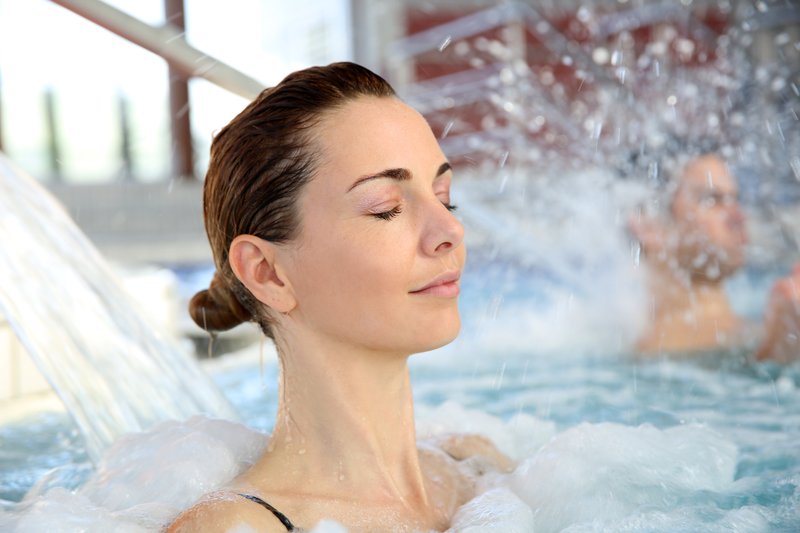What is Hydrotherapy Good For? See All the Amazing Benefits

Water, water everywhere… and for every purpose? Well, water may not be good for literally every purpose, but it turns out that it’s useful for a whole lot more than just bathing and drinking. While showering and bathing do a body good, and drinking your eight daily glasses of water (at least) is hugely important for healthy living, there are many hydrotherapy benefits you are probably less familiar with that you can use to your advantage.
What Is Hydrotherapy?
You may think “swimming” when you hear the term “hydrotherapy,” but it turns out that hydrotherapy involves much more than just aquatherapy (the use of pools and swimming as a form of physical therapy). In reality, using water, ice, and/or steam for therapy, healing, and pain relief is a common and effective part of many physical therapy programs.
It’s not something new. Using the properties of water pressure and manipulating water temperature to promote pain relief and healing dates as far back as Roman times. Even Hippocrates was known for prescribing spring water baths to speed recovery.
Now, in modern times, water pressure is used to massage, while hot and cold water have various therapeutic uses, as do ice and steam, and are often used in conjunction with other forms of physical therapy to promote healing and speed recuperation.
The Different Types of Hydrotherapy
If this hydrotherapy thing sounds interesting to you and you’re wondering what types of hydrotherapy are available, here’s a list of some of the more popular uses of water in its various forms plus all the hydrotherapy benefits:
Steam room—this type of therapy can often be found at a salon or spa. Many fitness facilities, as well as membership clubs (golf courses and clubs, for example), have steam rooms available for their patrons.
A steam room is excellent for allowing your muscles to warm and loosen up either prior to a workout or immediately after. It involves sitting in a room that’s heated to a little over 100 degrees. Steam from boiling water is piped into the room to provide you with a steamy, hot environment. This also allows you to sweat out toxins as you breathe in the healing, moist heat.
Hot foot bath—often used to help one relax, simply soaking the feet in hot water can help reduce inflammation and congestion all while boosting your immune system. Try to soak for 20 – 30 minutes for maximum effectiveness.
Wastu massage—this type of massage involves a therapist and a patient working together in a large tub of water that’s deep enough to allow the patient’s body and limbs to float and move through the water. The therapist will continuously move, stretch, and massage the muscles under the warm water. Treatment can even include breathwork during the gentle stretching.
Sitz bath—this is not your normal “bath.” A sitz bath involves sitting in only about three inches of warm water and is designed to help promote blood flow and heal and reduce pain in the genital and rectal areas (after childbirth, for example).
Immersion in a warm water bath—this is your typical bath with a twist. Add Epsom salts to soothe stiff, strained, or sprained muscles. You can also add other salts or essential oils to enjoy an aromatherapy bath for some soothing relaxation.
Hot water bottles and compresses—you may remember your mother putting you to bed with a hot water bottle when you were sick. A hot compress or water bottle can feel good on sore muscles and can help ease a cough or cold.
Pool therapy—physical therapy done in a pool is a great way to convalesce. Also called “aquatic therapy,” pool therapy can help get a patient moving sooner. Since it’s easier for some patients to balance and move in the water, a pool is the perfect place to work on flexibility, coordination, and muscle strengthening.
Cryotherapy—once again, a therapy involving water; however, this type of therapy uses ice, extremely cold water, and ice baths to help reduce inflammation, pain, and swelling and heal tissue more quickly. Extreme forms of cryotherapy (like dry ice or nitrogen chambers) may even help you burn additional calories since the temperature is well below -100 degrees.
Contrast hydrotherapy—this involves alternating the use of hot and cold water to open blood vessels and then, alternatively, the application of cold water to close down the vessels and to repeatedly stimulate the muscles and nervous system. This can promote faster healing of injuries and even boost the immune system.
Additional Hydrotherapy benefits
- Osteoarthritis and Arthritis—water therapy can help lessen the pain of osteoarthritis and assist in therapeutic movements such as stretching and pulling and pushing movements in the water. The warm water helps soothe achy joints and supports the limbs as they move gently through the water.
- Loosen joints—water can also be used to loosen stiff joints by using water as a gentle form of resistance to practice pushing and pulling movements against.
- Reduce stress—there is just something soothing and natural about being in the water. Feeling relaxed can help reduce your levels of the stress hormone cortisone.
- Strengthen muscles—hydrotherapy is proven to help strengthen muscles over time. The water supports the limb and provides resistance as you move through the water. The faster you move, the greater the resistance offered.
- Improve circulation—hot water can open blood vessels and promote blood flow, while cold water and ice can help reduce inflammation and induce healing.
- Boost immune system—all of the above types of hydrotherapy can benefit the immune system in one or more ways.
You can find hydrotherapy available at most hospitals. Additionally, physical therapists will often have access to pools and hydrotherapy equipment. You can also check your local spas, membership clubs, and fitness facilities to see if they provide such features. So dive in and enjoy the hydrotherapy benefits!






